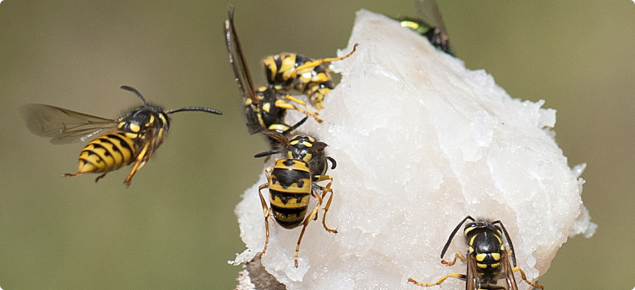Key impacts of European wasps
The European wasp, Vespula germanica, is native to Europe, North Africa and temperate Asia. It has successfully invaded other countries by hitchhiking on planes, ships and road vehicles. The wasp has become established in North America, Canada, Chile, Argentina, South Africa, New Zealand and in south-east Australia (SA, NSW, ACT, VIC and TAS).
While occurrences of European wasp in Australia have been documented since 1960, the Western Australian European Wasp Eradication Program has successfully eradicated each detected wasp incursion in WA. Each year fertilised wasp queens arrive in WA via freight and cargo from the eastern states. The queens spread out to find suitable places to start new nests that can house many thousands of wasps.
European wasps can have significant negative impacts in the region they invade, for example:
- The wasps pose a safety risk to outdoor activities due to their foraging habits, aggressive behaviour and hidden nests – e.g. they can affect maintenance and field staff, bush walkers, picnickers, residents, café patrons, orchardists etc.
- Their underground nests are difficult to see and disturbing a nest can lead to thousands of wasps attacking.
- Risk to the environment – wasps compete with and predate on native insects; reducing insect numbers, biodiversity and ecosystem function.
- They forage for human food and drink, as well as pet food – causing a nuisance and a health concern to people and pets.
- They damage horticultural crops like grapes and stone fruits, and predate on bees in managed apiaries – impacting industry and home gardeners.
Due to favourable environmental conditions and the lack of natural predators, the European wasp has the potential to become a greater pest in WA than anywhere else in the world.
Without ongoing surveillance, trapping and public reporting, European wasps would likely become established in WA. The predicted range of establishment for European wasp in WA is from Kalbarri to Eucla.
The importance of taking action
Outside its natural habitat of Europe and North Africa, this wasp is a serious social, environmental and agricultural pest.
Large wasp populations would threaten WA’s outdoor lifestyle, tourism, human health and the well-being of our pets and livestock. Horticulture, viticulture and apiculture industries would also suffer if this pest became established in WA.
Since 1994, the department has been working with the community to conduct a surveillance and eradication program. Increased community awareness and reporting ensures this program is a success. Learn more about the Adopt-a-Trap Program to see how you can help.
For more information contact:
Pest and Disease Information Service (PaDIS)
Telephone:+61 (0)8 9368 3080
Email: padis@dpird.wa.gov.au



